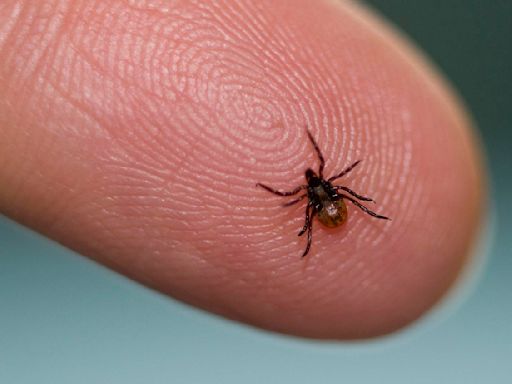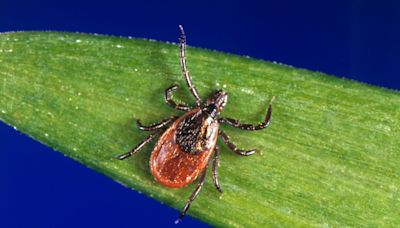Search results
Oct 21, 2021 · Learn how to prevent, remove and check ticks, and what to do if you are bitten by one. Find out about symptoms, diagnosis and treatment of tickborne diseases, such as Lyme disease, Rocky Mountain spotted fever and tickborne encephalitis.
- Remove Ticks
Different ticks live in different parts of the country and...
- Tickborne Disease Surveillance Data Summary
Ticks. Tickborne Disease Surveillance Data Summary. Print....
- Tickborne Disease Continuing Education
Avoiding ticks; On people; On pets; In the yard; Removing a...
- Ticks Home
Avoiding Ticks. Related Pages. Preventing tick bites....
- Preventing Tick Bites
Know which ticks are most common in your area. Before You Go...
- Remove Ticks
- Hard Ticks
- Soft Ticks
- Know The Types of Ticks
- GeneratedCaptionsTabForHeroSec
Hard ticks (Ixodidae) begin as an egg that is laid by an adult female tick. Once the egg hatches a larva emerges that must then find and feed on a small mammal or bird (host). After feeding it drops to the ground from the host and goes through a molting process, emerging as a nymph. Nymphal hard ticks then seek larger hosts, and after feeding drop ...
Soft ticks (Argasidae), like hard ticks begin as an egg, hatch into a larva, feed and then molt into a nymph. Nymphal soft ticks may go through as many as seven phases as nymphs, requiring a blood meal at each stage. Soft ticks’ life cycle lasts from months to years depending on the species. The bite is typically painless and only lasts 15-30 minut...
American Dog Tick
The American dog tick have a dark brown body. Females have an off-white shield, while adult males look more mottled. The greatest risk of being bitten is from the adult females during the spring and summer months. Pathogens: This species is the primary vector of the bacteria that cause Rocky Mountain spotted fever ((Rickettsia rickettsii)). It is also known to transmit Tularemia (Francisella tularensis), Ehrlichia, Anaplasma,and tick paralysis. Location:This tick has a broad distribution east...
Blacklegged “Deer” Tick
This tick is most easily identified by its reddish-orange body, black shield and dark black legs. Pathogens: The deer tick is known to transmit Borrelia burgdorferi (the agent of Lyme disease), Borrelia mayonii (which causes a Lyme-like illness), Borrelia miyamotoi and Borrelia hermsii (that both cause relapsing fever Borreliosis), Ehrlichia muris (ehrlichiosis), Anaplasma phagocytophilum (anaplasmosis), Babesia microti (babesiosis), multiple species of Rickettsia, deer tick virus, and Powass...
Brown Dog Tick
The brown dog tick is a reddish brown with a narrow shape in comparison to other ticks. Pathogens: All life stages of this tick can transmit Rocky Mountain spotted fever (Rickettsia rickettsia), Q Fever, and other rickettsioses to humans. They can also transmit several diseases specific to dogs. Location:Dogs are the primary host for the brown dog tick which is found world-wide. The brown dog tick can survive and breed in nature but live primarily in and around homes with dogs (for example, d...
Learn about the two families of ticks found in the United States: Ixodidae (hard ticks) and Argasidae (soft ticks), and the 700 species of hard ticks and 200 species of soft ticks that can transmit disease to humans. See pictures of different types of ticks and their locations, and how to identify them.
Oct 9, 2023 · Learn how to identify ticks and tick bites, along with the symptoms of tick-borne diseases and how to treat them. Find out how to remove a tick safely and prevent infections from tick-borne diseases.
- Are tick bites itchy?A tick bite can cause immediate, intense itching in some people due to the toxins and irritants in tick saliva. However, itching doesn’t always occ...
- Can you get Lyme disease if you don’t see a ring around the tick bite?Yes. The EM rash is often a surefire sign that you’ve been bitten by a tick carrying Lyme disease. However, not everyone gets the rash. Since it do...
- Can ticks carry diseases other than Lyme disease?Yes. Ticks can carry many diseases, such as Rocky Mountain Fever. The diseases ticks carry vary from geographic region to region.
- Where do ticks live?Ticks live outdoors. They hide in grass, trees, shrubs, and underbrush. If you’re outside hiking or playing, a tick might attach itself to you or y...
- What does a tick bite look like?A tick bite may cause a small bump. Some tick-borne diseases can cause a rash. You may also develop a rash due to an allergic reaction to a tick bi...
- How do you tell if a bite is from a tick?A tick bite can look like another insect bite. But you may identify the tick in your skin If you live in or have traveled to an area where ticks ar...
- When should I worry about a tick bite?If you live where tick-borne diseases are common, you may want to talk with a doctor after a tick bite, even if you do not have any symptoms. They...
- What does a tick bite with Lyme look like?Some people develop a bullseye rash, erythema multiforme, with Lyme disease. However, not everyone with Lyme disease develops this rash.
- Black-legged tick or deer tick. The black-legged tick, also known as the deer tick, is mainly found in the eastern half and Midwest region of the U.S. The scientific name for this tick is Ixodes scapularis.
- Lone Star tick. The Lone Star tick is mainly found in the Southern and Eastern U.S. Its scientific name is Amblyomma americanum. The Lone Star tick can spread
- Alpha-gal syndrome and the Lone Star tick. Bites from the Lone Star tick can sometimes lead to alpha-gal syndrome, which is associated with a meat allergy.
- American dog tick. The American dog tick is mainly found east of the U.S. Rocky Mountains. The scientific name for this tick is Dermacentor variabilis. The American dog tick also is found in some areas of the Pacific Coast.
Ticks are parasitic arachnids of the order Ixodida. They are part of the mite superorder Parasitiformes. Adult ticks are approximately 3 to 5 mm in length depending on age, sex, species, and "fullness". Ticks are external parasites, living by feeding on the blood of mammals, birds, and sometimes reptiles and amphibians.
- Ixodida
- Animalia
People also ask
What does “in a tick” mean?
What is a tick borne disease?
Are ticks a pathogen?
Sep 2, 2020 · Ticks are small bugs that suck the blood of humans and other animals. They can transmit diseases, such as Lyme disease, Rocky Mountain spotted fever, and tularemia. Learn about the types of ticks that live in the U.S., their pictures, and how to avoid, remove, and see a doctor if you have a tick bite.







